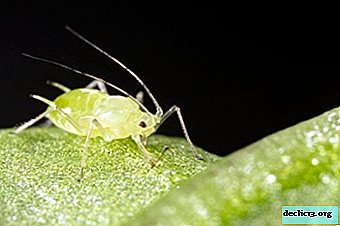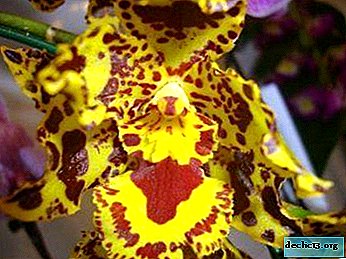A small insect that causes great harm - aphids. Description with photo, structure, habitat and breeding
 Scientists have about 4000 species of aphids, 1000 of them live in Europe. Many species harm crop plants and are carriers of plant viruses.
Scientists have about 4000 species of aphids, 1000 of them live in Europe. Many species harm crop plants and are carriers of plant viruses.
In this article, we will talk in detail about the features of this insect. And also the reader will be able to get acquainted with the aphid photo and find out which family it belongs to, and which plants it prefers to inhabit. The article describes the significance of the insect in nature and how it reproduces.
What is this family?
Let’s find out to which detachment this pest belongs, whether it feeds on plants or not, why it is called a “cash cow”. The family of aphids or Aphididae (lat.), In English - "aphid" refers to the order of semi-winged or arthropods, from the family of real aphids. This is a herbivorous insect, it eats plant juice, which is rich in carbohydrates. From it, the insect extracts protein. After drinking juice, a sweet solution is released, so it removes excess sugar from the body.
This solution is very popular with other insects, for example ants, which I specifically extract from the insect, and in return take care of their “herd” - they protect it or transfer it to new plants. Therefore, aphids are sometimes called "cash cow". Consider how much the insect lives. In various forms, an insect can live from several days to one month. And at an air temperature of up to 10 degrees, the female aphid can live up to 60 days.
Description, structure of an individual
The insect has an ellipsoid body shape. On the trapezoid head, from 4 to 6 segmented antennae are located, here are the organs that are responsible for touch and hearing. Also, the insect has multi-faceted eyes on its head. They can be black, brown or red.
The sucking mouth is presented in the form of a special proboscis, with which aphids pierce the plants and suck out their juice. Insects that live on cereals have a short and dull proboscis, while those that feed on wormwood have a long and pointed proboscis.How it looks: description and photo
The aphid has a green, white shade of the body, sometimes it is brown or reddish, pink or yellow - the shade coincides with the color of the fodder plants. The most common size is from 0.5 mm to 2 mm, but there are individuals that reach 7 mm. All species of aphids are both wingless and winged. The wings are usually two pairs. The rear is smaller than the front. They are transparent or slightly darkened.
Reproduction of aphids at the beginning of the life cycle occurs without a male. They are born only at the end and, depending on the species, differ from the female in color and size. They are usually smaller than the female.
Who such aphids can be understood by looking at the photo of this insect on a plant:





Where does such a pest live?
Consider where the pest lives, where it comes from in the garden. The insect loves a warm and humid climate, which allows you to actively reproduce and produce the greatest number of generations in one season. The aphid habitat covers a huge region - from Western Europe to Siberia. Most species live in tropical and subtropical climates.
Rapid changes in temperature and adverse weather conditions, such as rainfall or severe drought, interfere with insect reproduction. If the summer is cold and rainy, the aphid population decreases. The best habitat for the insect is the area on which there are few of their natural enemies, for example, ladybugs, and many ants live. Because, as we already wrote above, ants protect and care for aphids.
Aphid eggs do not withstand frost, starting from 25 degrees below zero and die.Aphids can be found in the aboveground part of the plant or underground - it sticks to the roots. In the garden, the insect settles on the grass, but then returns to the original plant again. It can be found in greenhouses, where it falls with unsterilized land. Aphids survive and develop, because the plants are not treated on time from the pest.
Features: value in nature
Consider the importance of the insect in biogeocenosis. Not only does aphid harm plants, it also regulates photosynthesis - sucks out excess sugar, along with the juice of the plant. Sweet insect secretions when it enters the ground fertilize it and saturate it with nitrogen.
This insect is also useful for ants with which they have symbiosis. Ants feed on her juice.
Many gardeners believe that aphids bite. However, it is not. Contact with an infected plant may result in irritation. But this is not a bite of aphids.
How does it breed?
 Let us find out how the insect reproduces, how it appears, what is an asexual individual. To understand the characteristics of aphid reproduction, it is necessary to describe its life cycle.
Let us find out how the insect reproduces, how it appears, what is an asexual individual. To understand the characteristics of aphid reproduction, it is necessary to describe its life cycle.
Type of development - incomplete transformation: the insect begins to develop in the spring, with the appearance of the larva. She hatches from an egg that was laid in the fall. However, in some species, for example, in phylloxera grape, wintering larvae are found under certain environmental conditions.
The larva eats juices of young shoots of plants. The first larvae of the insect's life cycle are called the founders or virgin females. They will not have wings and they will live on the same plant on which they appeared. The task of wingless virgins is to produce several more generations of the same females.
Parthenogenesis is a unisexual reproduction in which female reproductive cells produce individuals of this species without fertilization.When developing from an unfertilized egg, that is, by means of parthenogenesis, a certain form of meiosis occurs in these females, which occurs without separation of the chromosomes - all chromosomes are transferred to the egg. The eggs develop in the body of the female and young individuals are born fully formed, and do not appear from the eggs. This process is called live birth. Throughout the summer, females give birth to offspring in this way.
Then the first generation of insects with wings is born in aphids. These are the so-called winged virgins or settlers. Their task is to resettle the colony in other plants, where new generations of aphids continue to give birth to live births, until a cell is obtained from which the future male develops parthenogenetically. It happens in the fall. At the same time, females are born, ready for fertilization. These are the so-called normal females and males.
Fertilized females lay diploid eggs. They hibernate, and in spring females hatch from them, breeding parthenogenetically and giving birth to living descendants. Several parthenogenetic generations are replaced by generations resulting from normal sexual reproduction, which introduces genetic diversity into the population as a result of recombination.
The main advantage that parthenogenesis provides to these insects is a rapid population growth, since all its adult individuals are capable of laying eggs. This is especially important during periods when environmental conditions are favorable for the existence of a large population, i.e. in the summer months.
 However, among certain species of aphids, other forms of biological development can be found. There is an aphid that moves around the plant. For example, grape aphids first develop on the vines of the grapes, and then move to its root system.
However, among certain species of aphids, other forms of biological development can be found. There is an aphid that moves around the plant. For example, grape aphids first develop on the vines of the grapes, and then move to its root system.
Aphid destroys fodder plants, and due to sweet secretions it attracts not only ants, but also other harmful insects. It carries phytopathogenic viruses that are dangerous to plants. In this case, one species can carry up to a hundred different pathogens. The insect is very prolific and in one life cycle you can produce tens of thousands of pests.
Knowing the features of the vital activity of this insect and knowing how to recognize it on plants, you can take the necessary control measures in time.
To prevent the spread of aphids, use soil loosening and destroy basal shoots. Spray the crowns of trees and treat the soil with special substances. Of the biological methods of struggle, natural aphids, such as ladybugs, are used.

















